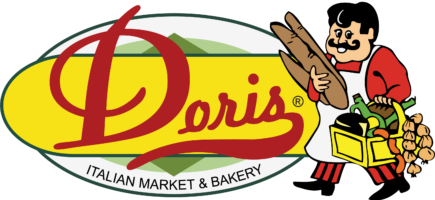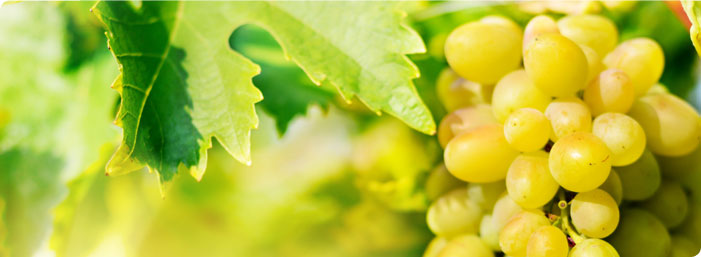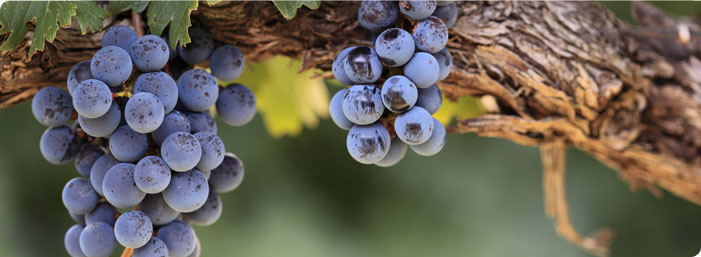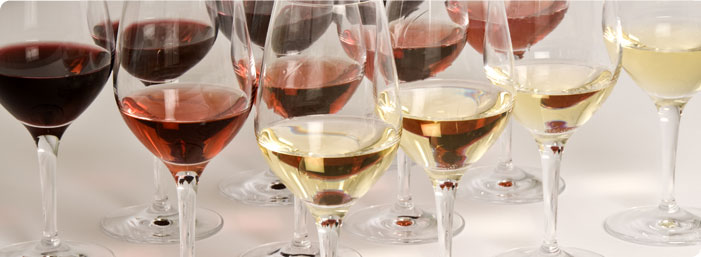Wine glossary of terms
The following glossary contains the most used terms within the wine industry. Become an honorary sommelier and learn the proper verbiage of wine!
Acidity
Acidity is a vital, naturally-occurring component of wine. It helps red wines preserve their color and dictates the ability to age. It also gives white wines their characteristic balance.
Too much acidity, and the wine will be tart and unpleasant; too little, and the wine will taste flat and uninteresting. A balanced wine is considered to have an acidity level between 0.6 to 0.75 percent.
Ageing
Wine tends to get better with age. Ageing refers to the process of leaving wine for a period of time to allow its components to blend together, harmonize, and develop complex flavors.
Alcohol
Commonly used term for ethyl alcohol. It is formed by the action of natural or added yeast on the sugar content of grapes during fermentation.
Appellation d’Origine Contrôlée
A label awarded to French wines, often known for its acronym AOC, which guarantees a wine was produced in the region specified, using certain vines and production methods.
Aroma
The smell of a wine. A wine’s aroma originates with the grapes. Wine sommeliers can easily distinguish the grapes used in a wine based on its aroma.
Astringent
Astringent refers to wines that leave a rough, coarse, drying, or furry sensation in the mouth. Astringency is usually related to high tannin levels found mostly in red wines.
Auslese
German term that translates to ‘selected harvest’. Most Auslesen wines tend to be sweet, but can be fermented in drier styles if desired.
Austere
Often used to refer to wines that are a bit too severe on the palate. Usually said of young wines or wines that don’t have richness and body.
Balanced
It is said a wine is balanced when all its elements, including tannins, acidity levels, and the fermenting process work harmoniously. The hard components balance out the soft components, creating a balanced wine.
Balthazar
A large format bottle that can hold up to 16 bottles of wine.
Barrel fermentation
The process of fermenting the wine in small casks – usually oak barrels.
Barrique
A barrique is the French term for a 225-liter oak barrel, which is considered small. Barrique translates exactly to barrel.
Beerenauslese (BA)
Another German cataloguing that classifies wines based on the ripeness and sugar content of the grapes. Wines that obtain a BA classification are costly and very rare.
Blind tasting
The practice of tasting without knowing information about the wine. It could be a single blind tasting, which consist of “blinding” the producer and price of a wine. Or it could be a double blind tasting, which means none of the characteristics of the wine are known.
Body
A term used in wine tasting to describe the weight of the wine in the mouth. Sommeliers will often use terms like light-bodied, medium-bodied, or full-bodied to describe wines.
Bordeaux
Bordeaux is a famous wine region in southwest France. Bordeaux is used to refer to a wine that contains a blend of the Merlot, Cabernet Sauvignon, Cabernet, Franc, Petite Verdot, and Malbec grapes.
Botrytis Cinerea
A notable mold that grows on ripe wine grapes under specific climate conditions. It is also known as “noble rot.” Wines with berries affected by this mold have a complex, rich, honeyed character and are often high in residual sugar. Most wines from Germany, Aszú, and Sauternes, categorized as BA often have an assortment of these berries.
Bouquet
Although it does refer to the smell of the wine, contrary to the wine’s aroma, the bouquet develops after it has been bottled and aged.
Brut
Often used to describe dry champagnes or sparkling wines. The scale from driest to sweetest is as follows: Brut Nature (driest), Extra Brut, Brut, Extra Dry, Dry, Demi-Sec, Doux (sweetest).
Buttery
Literally means a wine smells like melted butter or tasty oak. It is also often used to describe texture.
Cava
Spanish sparkling wines made using the traditional champagne method.
Cedar
A term used to talk about the smell of cedar wood, often associated with mature Cabernet blends aged in cedar wood.
Cellar
The room in a winery where wine is stored. It is suggested that the wine should be kept away from high temperatures, direct light, large temperature swings, and vibration, which is why they tend to be stored in special rooms.
Cépage
A common French term used to refer to grape variety.
Chaptalization
The process of adding sugar to the juice before and/or during the fermentation process. Often used in grapes that are not ripe enough.
Claret
An old-fashioned English term for red wines from Bordeaux.
Classed growth
The famous Bordeaux Wine Official Classification of 1855, which, at the behest of Napoleon III, ranked wines of the region based on the prestige and trade price of the château where it was produced. Wines were ranked from first-growth to fifth-growth.
Clean
A tasting term used to refer to wines that are fresh on the palate and don’t have any off flavors.
Closed
A term used to describe wines that are concentrated, yet are shy in aroma or flavor.
Corked
The correct term to talk about a wine that has musty, off-putting flavor and aroma aftertaste caused by a tainted cork.
Cru
Cru often refers to a single vineyard or a group of vineyards.
Decanting
A technique that’s used to remove sediments from the wine before drinking. It is also a technique used to infuse air into the wine, which is said to be helpful in exploding the wine’s aromas.
Demi-sec
A French term used to designate medium-sweet champagnes or sparkling wines.
Dosage
The process of adding a small amount of wine (often mixed with sugar) to a bottle-fermented sparkling wine or champagne.
Eiswein
Eiswein is an official German classification for wines made from grapes that have frozen on the vine.
Extract
The depth, concentration, and richness of fruit flavors in a wine. To calculate this, wine makers measure dry residue left after the wine is boiled.
Fermentation
The process in which yeast converts sugar into alcohol. Through this process, wine makers turn grape juice into wine.
Filtration
The process of pumping wine through a pad to remove leftover grapes or particles. Most wines are filtered for clarity and stability.
Fining
A process used to remove solid particles that often settle at the bottom of the bottle or the barrel from a wine in order to make it clear.
Finish
A term that refers to the taste or flavors that remain in the mouth after the wine is tasted. For example, a finish can be alcoholic, bitter, hot, dry, acidic, short or long.
Fino
Fino is the word used to classify the driest sherry wines. Finos are aged under a layer of yeast cells, called a ‘flor’.
First growths
One of the categories conferred at the Bordeaux Wine Official Classification of 1855, “Premiers Crus” in French. The term refers to the top-rated estates of the time. For red wines, these estates are now known as Château Lafite Rothschild, Château Haut-Brion, Château Margaux, Château Latour, and Château Mouton-Rothschild. Some of the original 9 estates known as first growth have split. These estates are now known as Château La Tour Blanche, Château Rabaud-Promis, Château Sigalas-Rabaud, Château Coutet, Château de Rayne-Vigneau, Château Guiraud, Château Lafaurie-Peyraguey, Château Clos Haut-Peyraguey, Château Climens, Château Suduiraut, and Château Rieussec.
Flabby
A word used to describe a wine that doesn’t have enough acidity to balance the other elements.
Fortified
Indicates a wine whose alcohol content has been increased by adding neutral spirits or brandy.
French paradox
A phrase used to refer to the mystery behind French’s low rates of coronary disease, despite their high-fat diets.
Fresh
Tasting term for a wine that has a clean, fruity character.
Fruity
Although technically grapes are fruits, not all wines are fruity. It’s a wine tasting term used to refer to wines that have an aroma and taste of fruits.
Green
A term used to describe the testing of unripe fruit – this tends to give the wine a raw and acidic taste that is not always pleasant.
Hard
Term used to refer to high acidity or tannins. Most young red wines fall within this category.
Harvest
The process of picking grapes, whether by machine or by hand. It’s also used to refer to the period when the grapes are picked.
Herbaceous
A term used when the concentration of aromas is high and starts becoming less pleasant.
Hermitage
A wine AOC located in northern Rhône wine region of France famous for its red wines from the Syrah grape. The white wine from Hermitage is also highly regarded. The Hermitage only produces 60,000 cases of wine per year, keeping these wines in high demand.
Hogshead
Another name for a small oak barrel used to ferment mature wines.
Irrigation
The process of watering the grape vines. There are two often used methods, drip irrigation or flood irrigation.
Jeroboam
A term derived from the biblical first king of the northern Kingdom of Israel, which is used in France to describe different sizes of extra-large wine bottles holding from 3 to 4.5 liters of wine, or 4 to 6 bottles.
Lactic acid
A smooth acid created during winemaking when lactic acid bacteria (LAB) is used. Wines with lactic acid taste softer and less acidic.
Lambrusco
Lambrusco is a red Italian grape variety, and the name of the wine produced from the Lambrusco grape.
Late harvest
A term often found on labels to indicate to users that a wine was made from grapes harvested later than normal and often at a higher sugar level.
Laying down
A term used to describe the way bottles should be kept in cellars to keep the cork moist.
Lean
Tasting term referring to a wine that has high acidity, which cause the mouth to pucker and taste sharp to the mouth. The opposite of “round” or “fleshy.”
Leathery
A term often used to refer to the texture of the wine, indicating that a wine is tough and chewy, but in others cases it may be used to describe a wine that smells of old leather.
Lees stirring
Also known as bâttonage, in its French translation. Refers to a trick in which the dead yeast cells and extraneous grape material at the bottom of a barrel is wiggled around with a stick. This is typically done with white wines, and can create a more complex, creamy, rich flavor.
Long or length
Term used to refer to how long the flavor persists in the mouth.
Machine harvesting
Machine harvesters pass through the rows of vines literally beating the individual grapes off the vines with rubber paddles, which are then collected and separated from the non-grape material for transport back to the winery.
Magnum
A bottle of wine that holds up to 1.5 liters or the equivalent to two full bottles.
Malic acid
An acid found in high concentrations in unripe grapes, which has a tart, sharp flavor.
Malolactic fermentation (ML)
A secondary fermentation that happens due to a bacterial conversion in most wines. This natural process converts malic acid into lactic acid for a softer taste. Through this fermentation, total acidity is reduced, the wine becomes softer, complex, and rounder. Also, malolactic fermentation prevents further fermentation in the bottle, which could ruin the wine.
Methuselah
Another large-format wine bottle named after a biblical character, who was said to be the oldest man, that can hold up to 6 liters or eight bottles.
Must
The mixture of unfermented grapes, stems, and skins, extracted by crushing or pressing the grapes.
Musty
The result of wines made from moldy grapes. They tend to feature an off-putting or mildew smell. This taste often results from poorly stored wines in cellars or by contaminated corks.
MW
This stands for Master of Wine, and indicates that these dedicated individuals have passed the grueling professional exams set by the Institute of Masters of Wine.
Négociant
French term for someone who buys grapes, grape must, juice, or wines in different stages of the winemaking process. These merchants then produce, bottle, and market the resulting blend under their own label. Particularly found in Burgundy.
New World
A term used to describe wines from non-European regions such as Australia, United States, Chile, Argentina, South Africa and New Zealand.
Noble Rot
A noble rot is a beneficial mold that grows on ripe wine grapes in the vineyard in certain climatic conditions. Also known as Botrytis cinera, for its scientific name, it’s often found in BA and TBA wines from Germany.
Non-Vintage
Wines that are blended with grapes grown in more than one vintage. This allows vintners to maintain a house style from year to year. Most champagnes and sparkling wines are non-vintage, as well as many ports, sherries, and madeiras.
Nose
The character of a wine as noted by the olfactory sense. How a wine smells in the glass includes the aroma, and the bouquet.
Oaky
A term to describe the taste or aroma quality that a wine has because of the oak barrels or casks in which it was aged.
Old Vine
There are some wines that come from vines that are 50, 70, or even 100 years of age. Some wine bottles will note that they come from old vines. However, there are no legal regulations, so it’s hard to prove that they actually do.
Old World
Refers to the countries in Europe where winemaking dates back centuries. Usually associated with traditional wine making techniques.
Oloroso
Oloroso means odorous in Spanish. It’s a term used to describe the richest, darker category of dry Sherry. These wines often have alcohol levels up to 20 percent. Featuring a nutty, rich flavor from long ageing in oak casks.
Oxidized
A term used to describe wines that have been exposed too long to air and developed a brownish color, losing freshness and in some cases beginning to smell and taste like Sherry or old apples.
Phylloxera
A nearly microscopic aphid that attacks grape vine roots, feeding on the roots and leaves. An infestation can cause deformations in the roots, and fungal infections, which can gradually cut off nutrients and water from reaching the vine.
Press
A device used to squeeze juice out from grapes before fermentation begins.
Pressings
The solid gunk left over after squeezing all the juice out of crushed grapes.
Racking
The practice of moving wine from one container to another for aeration, leaving sediment behind. This term is often confused with decanting.
Rehoboam
This is a bottle size named after a biblical Israelite king, which holds 4.5 liters, or 6 bottles of wine.
Reserve
A term often found on wine bottles to indicate a superior bottle. ‘Reserve’ has no distinct definition, but examples may be wines made from selected grapes, or those aged lavishly in oak.
Residual Sugar
The unfermented grape sugar left in a finished wine, indicated on a bottle in grams per liter.
Rootstock
A disease-resistant Native American grapevine grown specifically to prevent attacks of Phylloxera in regions where this aphid is common.
Sec
French term for ‘dry’, as in the opposite of sweet.
Sherry
Sherry is a form of wine made in the Andalusia region of Spain, most often from the Palomino grape. After fermentation, the wine is fortified with distilled wine spirit, reaching up to 15.5 percent alcohol levels.
Solera
A set of barrels containing multiple vintages of wine or spirits that is arranged side by side or on top of one another. This is done to transfer younger wines to older barrels after a barrel has been emptied for bottling. Bottles of wine produced in a solera will contain traces of wine as old as the first batch produced in the system. This system is often used for ageing Sherry.
Sparkling red/Sparkling Shiraz
An Australian creation that vinifies Shiraz with champagne, producing a fizzy, frothy red wine.
Spätlese
The German classification for late harvest. These white wines are usually richer because their grapes contain higher concentrations of sugar at harvest.
Structure
A term used to describe the mouthfeel of a wine. Wines with low levels of acidity are often described as “lacking in structure” whereas when tannin levels are high a “firm structure” is the outcome.
Sur Lie
A term used to describe a wine that was aged on the lees: the gunk at the bottom of a barrel or tank that consists mostly of dead yeast cells and grape material.
Tannin
Tannins are naturally occurring compounds that give certain wines their characteristics of dryness or astringency. A wine with high tannins tends to be drier than one with low tannins. When a wine is high in tannins it is said to be tannic.
Tartaric Acid
The primary acid in grapes and wine. Tartaric acid contributes to the wine’s color and taste.
Terroir
A term to describe the interaction of climate, soil, topography, and drainage of a specific site, which effect the outcome and final finish of a wine.
Trocken
German term for ‘dry’.
Ullage
A term used to refer to the wine that is lost over time, used to describe old, fine wines. The ullage level is the amount of space between the cork and the surface of the wine, and is described by terms such as “low neck,” or “high shoulder.”
Vintage
Vintage indicates the year in which the grapes were grown. For a wine to be classified as “vintage,” 95 percent of the wine must come from grapes that were grown and picked in the stated calendar year.
Vanilla
If you detect the scent of vanilla in a wine, it’s a tell-tale sign that new oak (and in particular American oak) has been used at some stage in the winemaking process.
Varietal
A term used when a wine is labeled with a single grape variety. This is most commonly used in the U.S. and Australia.
Vat
A large container used to ferment, age, or store wine.
Verdelho
Portuguese white wine grape, originally from Madeira.
Vieilles vignes
A French term for old vines.
Vinification
Another term for winemaking – the act of creating wine from grapes.
Viscous
Tasting term used for wines that are thick, heavy-textured and concentrated.
Volatile Acidity
A term to describe excessive amount of acetic acid produced from the oxidation of alcohol, which gives the wine a sour, vinegary taste.
Yeast
Micro-organisms that turn sugar into alcohol and carbon dioxide during fermentation. The yeast used in winemaking is also used to ferment beer and make bread dough rise. Wine makers often use cultured, natural, or wild yeast during fermentation.
The wine world is vast, containing hundreds of terms that are used to better explain the process, the taste, the aromas, and the feelings wine evokes. With these terms you can start your journey to learn more about the wine culture and rival an expert sommelier.




